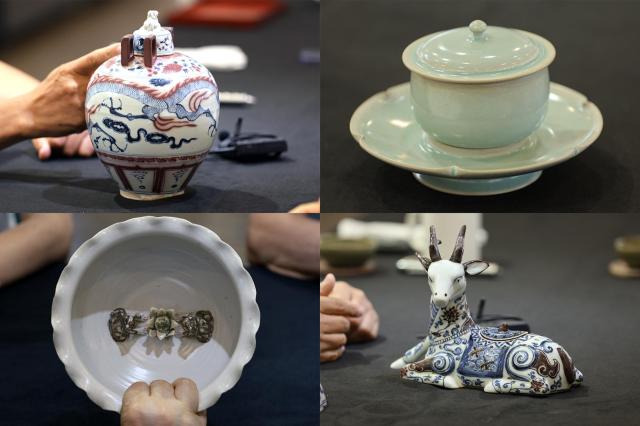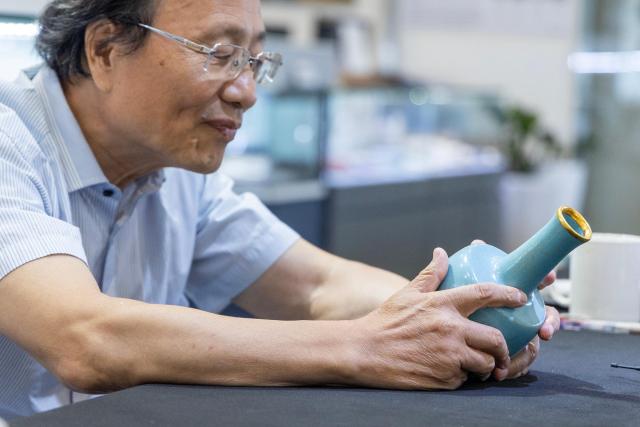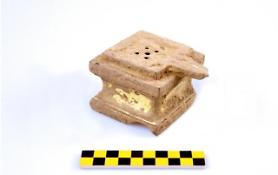
SEOUL, July 10 (AJP) - Daboseong Gallery in South Korea has once again opened its doors to reveal a selection of Chinese antiquities rarely seen by the public, even in China itself. For the third year running, the gallery invited top Chinese appraisal experts to assess items from its vast collection, believed to be one of the most extensive private holdings of rare Chinese artifacts in Asia.
The appraisal session, held on July 9, was led by Professor Lee Jung-soon of Chung-Ang University's Graduate School of International Studies. Invited to the gallery were Xuan Jiaxin, vice president of the Shanghai Calligraphers Association, and Chen Ketao, executive vice president of the Shanghai Collectors Association. The two spent the day examining a series of previously undisclosed Chinese relics, including calligraphy, porcelain, jade ornaments, and Neolithic artifacts.
At the center of this year’s review was a Geumnisagyeong, a Buddhist scripture copied in gold ink on indigo-dyed paper by Zhao Mengfu (1254~1322), one of the most influential figures in Chinese calligraphy. The manuscript is a transcription of the Mahāvaipulya Complete Enlightenment Sūtra (Da Fangguang Yuanjue Xiuxiuluo Liaoyi Jing), written in two long scrolls. The upper scroll measures 33 centimeters by 11.46 meters, and the lower one 33 centimeters by 11 meters. Both are stored folded in a 35-by-13.5-centimeter box. At the end of the lower scroll is written: "延祐二年春月三寶弟子趙孟頫敬書", which translates as "Respectfully written by Zhao Mengfu, disciple of the Three Jewels, in the spring of the second year of Yanyou," referring to the year 1315.
Zhao Mengfu, known for his mastery of all major Chinese scripts, including seal, clerical, regular, and cursive, was a towering figure in the Yuan Dynasty. His writing style, referred to as Songxue-ti or Zhao-ti, was widely admired not just in China but also in South Korea and Japan. His influence was especially visible during the early Joseon period, when his calligraphy gained widespread popularity. Beyond calligraphy, Zhao was also a painter, poet, and central figure in the artistic revival movement that promoted a return to Tang and Northern Song aesthetics.
The Yuanjue Sutra is a central Mahayana Buddhist scripture, presenting a dialogue between the Buddha and twelve bodhisattvas. It lays out the doctrine of Great Perfect Enlightenment and emphasizes the innate Buddha-nature of all living beings. In South Korea, the text remains an important guide in Buddhist practice.
Regarding the scripture, Xuan Jiaxin commented, "It’s the first time I’ve seen this piece, so it’s difficult to assign a price." He noted, however, that a similar work by Zhao had once fetched 30 billion won at auction in China.

Chen Ketao also evaluated several significant ceramic works, calling them exceptional pieces that could start at several hundred million to several billion won at auction. Among them were a Northern Song Ru ware celadon vase with a gilt rim, a covered Ru ware bowl with a lotus-shaped saucer, a Ding ware bowl decorated with lotus motifs, a late Yuan to early Ming blue-and-white jar with underglaze red cloud-and-dragon designs, and a Xuande-era incense burner in the shape of a deer, painted in cobalt blue and iron red.
The team also assessed several jade ornaments associated with the Hongshan culture, including the yuzhulong, a pig-dragon figure carved from jade. The Hongshan culture, which thrived 5,000 to 6,000 years ago, is often referred to as the beginning of Chinese civilization. Most of its relics were excavated from tombs and are considered key to understanding early spiritual practices in the region.
Daboseong Gallery began its expert appraisal series in 2022. Last year, the gallery invited Wu Shaohua, adviser to the China Collectors Association, along with Xuan and Chen, to examine its holdings. In July 2023, three more experts, Ye Peilan of the China Cultural Relics Society, Yu Hui from Beijing’s Palace Museum, and Gu Fang from the China Collectors Association, visited South Korea and reviewed over 70 pieces, including paintings, ceramics, and calligraphy.
That visit included the appraisal of an eight-meter painting attributed to Song Dynasty artist Shi Ke, as well as a lotus ewer from the Song period, a Yuan blue-and-red phoenix vase, a Ming blue-and-white dragon jar, and a Qing cloisonné lotus vase. The Shi Ke painting, like Zhao’s scripture this year, was described as being too rare to price. At the time, Xuan Jiaxin remarked that a comparable work by Northern Song calligrapher Huang Tingjian had sold at auction in Japan for 250 million yuan, or around 47.7 billion won.
Kim Jong-choon, chairman of Daboseong Gallery, said, "This is the third year we’ve invited Chinese experts to evaluate our collection, and each time, the value of our holdings has been affirmed." He added, "We’re creating a platform for cultural exchange through these appraisals and discussions. And with many relics still unreleased to the public, this work will continue."
Copyright ⓒ Aju Press All rights reserved.



